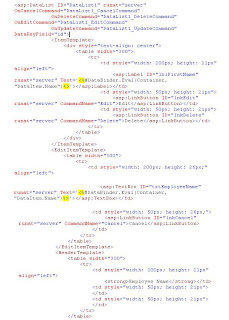|
| Wednesday, September 26, 2007 |
| DATALIST--INSERT, UPDATE AND DELETE operations |

The DataList Web server control is a data-bound container control that allows to customize the display of data. We can perform the insert, edit, update, delete operations.
This is just similar to the grid view control in dot net 2005.
How to bind data to a datalist?
1) Drag a datalist to the web form
2) Using Item template you can add the controls to display the data
(Look at the html view of the sample page)
3) Set the data source of the datalist.
What is the logic behind the Edit, Update, Cancel and Delete?
1) Add link buttons Edit with command name “Edit”, Delete with Command Name
”Delete” in Item template.
2) Also set the Edit Item Template of the datalist to show the data in a textbox
(See the html view of the edit item template), also add the link buttons Update, Cancel with corresponding command name “Update and Cancel”.
3) Set the events edit command, update command, delete command and cancel
Command of datalist similar in the grid view.
4) Also put the code given in the sample cs code.
What is the logic behind the INSERT?
1) Inserting a blank row at the position 0 of the data table.
2) Just renaming the existing “edit button” to insert and hiding the delete button
3) In the dataList1_UpdateCommand of the datalist, just checking the row index.
If row index is 0, it will be an insert operation.
Note: By setting the datakeyfield of the datalist, we can easily identify which row is going to update or delete.
HTML VIEW OF THE PAGE

Code Sample
#region Namespaces
using System;
using System.Data;
using System.Configuration;
using System.Collections;
using System.Web;
using System.Web.Security;
using System.Web.UI;
using System.Web.UI.WebControls;
using System.Web.UI.WebControls.WebParts;
using System.Web.UI.HtmlControls;
using System.Data.Common;
using System.Data.SqlClient;
#endregion
public partial class DataListTest : System.Web.UI.Page
{
#region Events
protected void Page_Load(object sender, EventArgs e)
{
if (!IsPostBack)
{
bindDataList();
}
}
protected void DataList1_CancelCommand(object source, DataListCommandEventArgs e)
{
DataList1.EditItemIndex = -1;
bindDataList();
}
protected void DataList1_DeleteCommand(object source, DataListCommandEventArgs e)
{
SqlConnection _con = getConnection();
_con.Open();
SqlCommand _cmd = new SqlCommand("delete from tblEmployee where id=" + DataList1.DataKeys[e.Item.ItemIndex], _con);
_cmd.ExecuteNonQuery();
_con.Close();
DataList1.EditItemIndex = -1;
bindDataList();
}
protected void DataList1_UpdateCommand(object source, DataListCommandEventArgs e)
{
SqlConnection _con = getConnection();
_con.Open();
SqlCommand _cmd = new SqlCommand();
if (e.Item.ItemIndex != 0)
_cmd = new SqlCommand("update tblEmployee set Name='" + ((TextBox)e.Item.FindControl("txtEmployeeName")).Text + "' where id=" + DataList1.DataKeys[e.Item.ItemIndex], _con);
else
_cmd = new SqlCommand("insert into tblEmployee (Name)values('" + ((TextBox)e.Item.FindControl("txtEmployeeName")).Text + "')", _con);
_cmd.ExecuteNonQuery();
_con.Close();
DataList1.EditItemIndex = -1;
bindDataList();
}
protected void DataList1_EditCommand(object source, DataListCommandEventArgs e)
{
DataList1.EditItemIndex = e.Item.ItemIndex;
bindDataList();
}
#endregion
#region Private Function
///
/// To bind the data
///
private void bindDataList()
{
SqlConnection _con = getConnection();
_con.Open();
SqlDataAdapter _da = new SqlDataAdapter("select * from tblEmployee", _con);
DataSet _ds = new DataSet();
_da.Fill(_ds);
_con.Close();
DataRow dr = _ds.Tables[0].NewRow();
_ds.Tables[0].Rows.InsertAt(dr, 0);
DataList1.DataSource = _ds;
DataList1.DataBind();
if (DataList1.EditItemIndex != 0)//just for the first row
{
((LinkButton)DataList1.Items[0].FindControl("lnkEdit")).Text = "Insert";
((Label)DataList1.Items[0].FindControl("lblFirstName")).Text = "click insert to add new employee";
((LinkButton)DataList1.Items[0].FindControl("lnkDelete")).Visible = false;
}
}
///
/// PURPOSE:To get the connection
///
///
private SqlConnection getConnection()
{
return new SqlConnection("server=.;uid=sa;pwd=;database=employeedb");
}
#endregion
}
Hope this will help you while dealing with data lists. |
posted by Giri @ 5:31 AM  |
|
|
|
|
|
